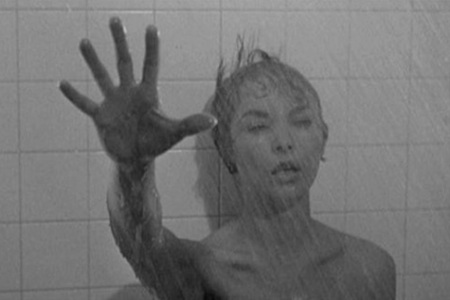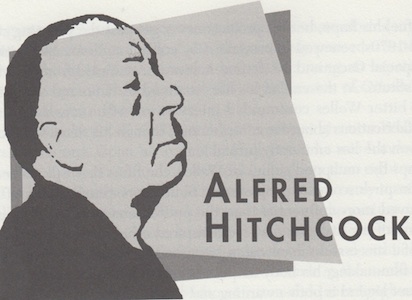Born: August 13, 1899, Leytonstone, England
Died: April 28, 1980, Bel-Air, CA
Hitchcock was the rare director who was familiar to audiences.
—Farley Granger
Even before Alfred Hitchcock pulled his greatest surprise, the chilling movie Psycho (1960), he was already the most recognizable director of all time. By defining an entire genre, and tailoring it to his own unique gifts, he had become the de facto master of suspense films. His trademark humor and experimental techniques were easily identifiable. His directorial style became the most imitated ever. More precisely, his name became synonymous with a spirit of moviemaking; to be “Hitchcockian” was to keep people clutching firmly to the edge of their seats.
Hitchcock began his career as an illustrator of title cards for the silent films of Jesse Lasky’s London studio in 1919. After advancing to art direction, he began picking up tips on screenwriting and editing, until his appointment as assistant director in 1922. His debut with a Jack the Ripper story, The Lodger (1926), provided an early hint at a personal style, featuring a mistaken-identity motif that he would use repeatedly. Thrillers quickly became his forte, and Blackmail (1929) was the first British talking picture to reap a profit.
The Film 100
1. W.K. Laurie Dickson
2 Edwin S. Porter
3. Charlie Chaplin
4. Mary Pickford
5. Orson Welles
6. Alfred Hitchcock
7. Walt Disney
8. D.W. Griffith
9. Will Hays
10 Thomas Edison
11. John Wayne
12. J.R. Bray
13. Billy Bitzer
14. Jesse Lasky
15. George Eastman
16. Sergei Eisenstein
17. André Bazin
18. Irving Thalberg
19. Thomas Ince
20. Marlon Brando
21. Louis B. Mayer
22. Greta Garbo
23. Robert Flaherty
24. Lon Chaney
25. Anita Loos
26. George Méliès
27. Adolph Zukor
28. John Gilbert
29. Max Fleischer
30. John Ford
31. William Fox
32. George Lucas
33. Linwood Gale Dunn
34. Eadweard Muybridge
35. Katharine Hepburn
36. Winsor McCay
37. Stanley Kubrick
38. Buster Keaton
39. James Agee
40. Fritz Lang
41. Marcus Loew
42. Cedric Gibbons
43. James Cagney
44. Ben Hecht
45. Ingmar Bergman
46. Humphrey Bogart
47. Leon Schlesinger
48. Louella Parsons
49. Roger Corman
50. Edith Head
51. Bernard Herrmann
52. Gary Cooper
53. Mike Todd
54. Ernst Lubitsch
55. Sidney Poitier
56. Saul Bass
57. Billy Wilder
58. Bette Davis
59. Erich von Stroheim
60. Max Factor
61. Auguste and Louis Lumière
62. Woody Allen
63. Clark Gable
64. David O. Selznick
65. Gregg Toland
66. Lillian Gish
67. William Cameron Menzies
68. Lucille Ball
69. Samuel Rothafel
70. Akira Kurosawa
71. Marilyn Monroe
72. Vittorio De Sica
73. Natalie Kalmus
74. Gene Siskel and Roger Ebert
75. Willis O’Brien
76. Shirley Temple
77. Yakima Canutt
78. Sam Peckinpah
79. Jackie Coogan
80. Federico Fellini
81. Leni Riefenstahl
82. Steven Spielberg
83. Sam Warner
84. Jean-Luc Godard
85. Robert De Niro
86. Fred Astaire
87. Francis Ford Coppola
88. Ted Turner
89. Clint Eastwood
90. Dalton Trumbo
91. Dennis Hopper
92. Richard Hollingshead
93. Melvin Van Peebles
94. John Chambers
95. Mack Sennett
96. Martin Scorsese
97. Karl Struss
98. Busby Berkeley
99. John Hubley
100. John Cassavetes
A prototypical Hitchcock web of intrigue was weaved in The 39 Steps (1935). By this time, Hitchcock had formed the habit of meticulously outlining his productions with extensive notes, hundreds of drawings, and an airtight script. The result was a tense chase film highlighted by unique characterizations from almost every player. An editing style was also apparent: Hitchcock closes in on a woman’s scream before cutting to a train whistle, an old radio effect that translated well to the screen. By The Lady Vanishes (1938), Hitchcock was streamlining his suspenseful techniques and adding large amounts of humor. An endless learner, he experimented with camera movement and restricted views to maintain prolonged tension. Hand-wringing audiences were soon becoming accustomed to his trickery, and Hitchcock’s reputation was met with Hollywood offers.
In 1939, producer David O. Selznick signed Hitchcock to a Hollywood contract that would begin with Rebecca (1940). Like other Hitchcock films, Rebecca stemmed from the fiction of mystery writer Daphne du Maurier. But Hitch was unhappy with the casting forced on him for his first American production, and for his second, Foreign Correspondent (1940). His panache seemed to have gone missing; then he adjusted to the studio system. Suspicion (1941) took the Master of Suspense into the sanctity of the family home for the first time, and audiences responded by coming to the theater. Suddenly, Hitchcock was a bankable director.
His success led to more creative freedom. On his next film, Shadow of a Doubt (1943), Hitchcock initiated a device that would become one of the most-used character clichés in all of cinema: the gentleman-killer. Attending a screening of Citizen Kane, Hitchcock was impressed with the ability of the meek actor Joseph Cotton. Cotton so epitomized the everyman, Hitchcock felt, that he effectively disappeared from his films, allowing ordinary folks to connect with extraordinary circumstances. Hitchcock soon cast Cotton as the villain in Shadow of a Doubt, a quiet suburban mystery that takes a unique approach to suspense by presenting Cotton as the quintessential “good uncle” who turns out to be a deeply disturbed predator of elderly spinsters. Cotton’s expert handling of the polite, unlikely murderer created a stereotype that has since become a staple of suspense films, repeated most memorably in Night of the Hunter (1953), Taxi Driver (1976), and even Hitchcock’s own Psycho. Shadow of a Doubt forced the audience to look twice at their neighbors and relatives, and perhaps for this very reason Hitchcock often cited the film as a personal favorite among his work.
Hitchcock’s uncommon talent, it seems, was his ability to compel onlookers to project themselves into the shoes of the bumbling innocents he engulfed in sinister situations. His films are the most effective demonstrations of how moviegoers empathize with screen characters.
Rope (1948) and Strangers on a Train (1951) both were inspired by the Leopold-Loeb murder case, as were a dozen other Hollywood films of the fifties. They received high praise as well as dependable box office, and Hitchcock was safely out of the meddling hands of producers; now a household name, he was coming into his own as a filmmaker. He was hailed by French New Wave theorists André Bazin and François Truffaut as the consummate film visionary. Hitchcock’s films looked remarkably distinct; the obvious special effects of the time didn’t demean the overall film–in fact, they combined to create a recognizable style. This consistency was largely due to Hitchcock’s training as an artist. On most films, he never bothered to employ an art director, and he was very fond of using storyboarding techniques in planning. Film executive David Brown claimed “he would no more improvise during shooting than the conductor of the New York Philharmonic would improvise while conducting.” His penchant for storyboarding became legendary, and later filmmakers, among them David Lean and Steven Spielberg, adopted this habit of visualizing every scene with detailed drawings.
Suddenly, bigger budgets and marquee stars were at Hitchcock’s beck and call, and his best films followed. Rear Window (1954), Dial M for Murder (1954), To Catch a Thief (1955), Vertigo (1958), and North by Northwest (1959) all received the lush Hitchcock look. He also began lengthy collaborations with costumer Edith Head, composer Bernard Hermann, and designer Saul Bass, all of whom helped polish his projects to perfection.
True to form, Hitchcock shocked his fans once more with Psycho (1960), a startling leap forward in suspense movies. The film became an instant classic and a primer for the use of point-of-view camera angles and quick cutting. Hitchcock’s studio, Paramount, didn’t want him to make it; they didn’t like the plot, the title, the ending, anything. They felt an unexpected amount of suggested nudity and graphic violence was as foreign to Hitchcock fans as the absence of black humor. Hitchcock, however, took on a new direction and delivered a movie that blurred the line between horror film and psychological thriller.
Two key scenes have had a lasting impact on the way horror films instill terror in audiences. The famous shower scene, in which a knife attack on a vulnerable hotel guest is presented as a rapid flash of disjointed images, gives viewers a dizzying perspective on the explosiveness of murder. The scene creates additional tension by frustrating viewers with cutaway shots of a static showerhead and running water in the midst of the violent act. The second influential scene involves the ambush of a private detective at the top of a staircase. In a moment of absolute silence, Hitchcock abandons the first-person perspective and shoots the set from overhead. This technique allows the audience to discover the location of the attacker just seconds before the victim does. Both of these mesmerizing scenes have been duplicated endlessly in the so-called splatter films of the horror genre.
Hitchcock followed with the eerie The Birds (1963), but struggled with difficult stars and shrinking budgets throughout the sixties. His final film, Family Plot (1976), was a well-received and fitting end to his career, applying his trademark wit to an exposé of the fashionable resurgence of clairvoyance. In 1979, the American Film Institute gave him a Life Achievement Award, and shortly afterward he was knighted by Queen Elizabeth II.
Alfred Hitchcock had earned his place in film history so early in his career that he lived with the “Master of Suspense” moniker for most of his professional life. He was a rare thing: a living legend, greatly appreciated in his own time. Since his death, the suspense genre has produced no worthy successor, although the techniques of Hitchcock are still present in the films of Brian De Palma, John Badham, and Peter Yates, among many others.
To read all the republished articles from ‘The Film 100,’ go to Reintroducing the Film 100 here on Keyframe.





